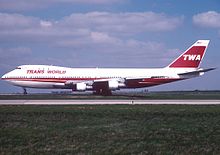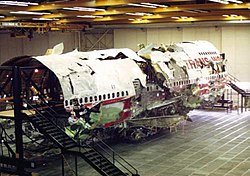Professionalism/TWA Flight 800
Introduction
[edit | edit source]
On July 17, 1996, TWA Flight 800 exploded en route to Rome only twelve minutes after its departure from John F. Kennedy International Airport, killing all 230 individuals on board. Debris were found near East Moriches, New York and led to an extensive investigation by the National Transportation Safety Board. The investigation ultimately concluded in the explosion being the result of an ignition in a fuel tank located close to the center of the plane.
Background
[edit | edit source]The Boeing 747-100 involved in the incident was manufactured in July 1971. It had completed 16,869 flights and had operated for 93,303 hours up until the day of the explosion. The day of the incident, the plane had already flown from Greece to JFK. After ten minutes into the flight, cockpit recordings showed the pilots acknowledging the fuel flow indicator showing "crazy" readings. Two minutes later, the aircraft exploded. There were a total of 736 witnesses on shore or in the ocean, about 500 claiming they saw the explosion and about 200 saying they had heard it.
Investigation
[edit | edit source]
The National Transportation Safety Board conducted an investigation to determine the cause of failure for TWA flight 800. This investigation took four years and resulted in a 341 page report which ultimately determined the most likely cause of failure to be an ignition of flammable fuel and air vapor in a fuel tank caused by a high voltage short circuit. Unlike US Airways Flight 1549, this investigation was only able to determine a most likely failure source and was not entirely conclusive in its results. Wreckage analysis combined with knowledge of the flight path of the plane led the investigators to determine that the failure zone of the plane was the area directly in front of the wings. Wreckage from this zone was found closest to JFK Airport which means it was the first to fall to the ocean and most likely the first zone to break apart. [1]
Failure Source
[edit | edit source]Once the investigators had an idea of where the failure occurred, they sought to find out what caused the failure. Many options were considered as a potential failure source. Structural failure and an ensuing decompression of the aircraft were ruled out based on lack of evidence of structural faults in the wreckage. A missile strike or bomb was ruled out by investigators again by lack of corroborating evidence in the wreckage associated with a high energy explosion. The recovered evidence had no severe cratering or petalling of the fuselage nor did it show any hot gas washing, both primary indicators of a high energy explosion. The investigators determined the most likely failure source was an ignition of fuel and air vapor in a fuel tank that led to an explosion and subsequent fire and destruction of the aircraft. The center wing fuel tank was determined to be the most likely location for the explosion for a couple reasons. First, it was located in the determined failure zone. Second, testing showed that the temperature in the tank would be sufficiently high for the fuel and air vapor to ignite due to uninsulated air conditioning packs directly below the tank which gave off heat as they operated. [1]
Ignition Source
[edit | edit source]Similar to the failure source, many possible ignition sources were considered. One considered ignition source was a lightning strike. This was ruled out based no witness testimony mentioning lightning and no recorded atmospheric disturbances in the area during the flight. Another consideration was an indirect missile strike where fragments of the missile penetrated the fuel tank. This was ruled out based primarily on wreckage evidence. There was no indication of numerous missile fragments striking the aircraft. Additionally, the missile fragments would need to penetrate several layers to reach the fuel tank and it was determined they would not have enough force to accomplish this. One obscure consideration which exemplifies the thoroughness of the investigation was a meteorite strike. This again was ruled out based on no evidence in the wreckage of an external strike as well as testimony from a Geology and Planetary Science professor who claimed a meteorite could be expected to strike a plane once every 59,000 to 77,000 years. The most likely ignition source was determined to be an electrical short circuit which passed into the fuel tank via the fuel quantity indicator system wiring and fuel quantity probes in the center wing fuel tank. Evidence showed that the insulation on the wiring had decayed to a point such that a high voltage short circuit between nearby wires would be possible. [1]
Recommendations
[edit | edit source]In order to prevent similar accidents in the future, the NTSB included a list of recommendations in their report. Many of these recommendations centered around wiring systems and maintenance of planes as well as considerations to ensure that fuel and air vapor in fuel tanks would never reach a flammable state. [1]
Boeing Study
[edit | edit source]In 1980 Boeing conducted a study on center wing fuel tank heating in their E-4B military model aircraft. This aircraft was similar to the 747, especially the design around the center wing fuel tank. The study concluded that the center wing fuel tank would be at a high temperature during a significant portion of operation due to extreme mission requirements and lack of insulation between the center wing tank base and the air conditioner pack bay. Boeing did not generalize the results of this study to the 747 and insulation was not added to 747's until after the TWA Flight 800 tragedy. Boeing also did not give this study to the NTSB investigation. It was given to the NTSB in 1999, 3 years after TWA Flight 800, by the Air Force Safety Center who had a copy because the E-4B was a military aircraft. [2] Boeing received scrutiny for both failing to act and insulate center wing fuel tanks in 747s and not giving the study to the NTSB. [3]
Conspiracy Theories
[edit | edit source]There were also ethical dilemmas after the incident. The formation and prevalence of conspiracy theories can provide insight into some of these dilemmas.
Possible Reasons for Formation
[edit | edit source]Trust in the US government was at a low in the 1990s during the Clinton administration. [4] This distrust may stem from major scandals facing President Clinton, such as the Whitewater and Lewinsky scandals. [5][6] There were also a number of terrorist attacks within ten years of the incident that led many to suspect this incident was also the result of terrorism. In 1988, Pan Am Flight 103 was bombed by a Libyan terrorist over Scotland, killing all 259 people on board and 11 people on the ground. [7] In 1993, the World Trade Center in New York City was bombed by a group of terrorists, killing six and injuring over a thousand people. [8] In 1995, a year before this incident, a federal government complex was bombed in Oklahoma City, killing at least 167 people and injuring hundreds more. [9] Conspiracy theorists also have suspicions over the NTSB's "conclusion" about the cause of the incident considering almost 5 percent of the wreckage had not been recovered as of 2000. [1] The FBI and NTSB also dismissed some of the eyewitness reports, particularly those that suggested a missile shot down TWA Flight 800, for reasons such as vague descriptions and interviewer or interviewee bias. [1]
Impact
[edit | edit source]Associated for Retired Aviation Professionals
[edit | edit source]Several interest groups formed in response to the TWA Flight 800 investigation. One of these interest groups, the Associated for Retired Aviation Professionals (ARAP), was founded by Retired Navy Commander William Donaldson in 1997. [10] While the FBI and NTSB quickly dismissed terrorism and domestic friendly-fire as possible causes for the explosion of TWA Flight 800, ARAP gave more attention to these theories, among others. In 1998, ARAP released a report concerning TWA Flight 800 as well as the investigation conducted by the FBI and NTSB. [11] The conclusion in this report directly opposes the conclusion of the later NTSB report, noting "there can be no doubt from this report that a spontaneously exploding center fuel tank was not the cause of the Crash of TWA Flight 800." [11]
TWA 800 Project
[edit | edit source]In 2013, 17 years after the crash of TWA Flight 800, a documentary called TWA Flight 800 was released by the interest group TWA 800 Project. The release of this documentary renewed conversation as to the cause of the incident. TWA 800 Project consists of former members of the NTSB investigation who waited to become public "whistle-blowers" in order to avoid retaliation from the NTSB for dissension [12].
Generalizations
[edit | edit source]Unlike many structural disasters, the incident of TWA Flight 800 is unique in the fact that the failure of the airplane did not come down to negligence by any one individual. Rather, this case can be more related to negligence over the years. This negligence could be directed towards the poor up keeping of the fuel quantity indicator system or the location of the air conditioner packs relative to the fuel tanks of the plane. It may even be directed towards Boeing's lack of generalization from the E-4B aircraft case. All in all, the ethical drive of different interest groups, such as the conspiracy theorists or the NTSB investigators, can lead to varying conclusions. However, it is the endeavor of professionals to be able to diminish these doubts and relate all pieces of evidence to form a unifying, decisive and undisputed conclusion.
References
[edit | edit source]- ↑ a b c d e f "NTSB Trans World Airlines Flight 800 Accident Report" (PDF).
- ↑ "Boeing Center Wing Tank Fuel Heating Study" (PDF).
- ↑ "Boeing Failed to Disclose 1980 Findings".
- ↑ "Public Trust in Government: 1958-2017".
- ↑ "Whitewater Time Line".
- ↑ "An Affair of State: The Investigation, Impeachment, and Trial of President Clinton".
- ↑ "Terrorist Bombing of Pan Am Flight 103".
- ↑ "The World Trade Center Bombing: Report and Analysis" (PDF).
- ↑ "Oklahoma City Bombing Injuries" (PDF).
- ↑ "Associated Retired Aviation Professionals".
- ↑ a b "Interim Report on the Crash of TWA Flight 800 and the Actions of the NTSB and the FBI" (PDF).
- ↑ "FAQs".
{{cite web}}: Text "Flight 800 Project" ignored (help)
